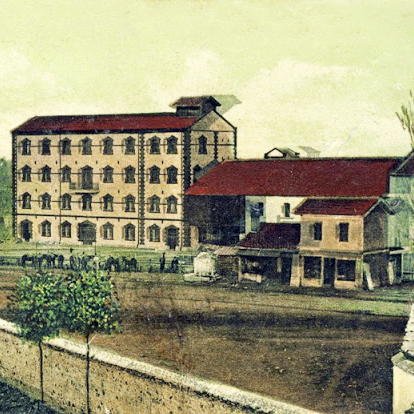ON THE INDUSTRIAL HISTORY OF NORTH MACEDONIA
North Macedonia attained independence very late compared to other European nations – and thus industrialisation was late and slow in coming as well. The natural prerequisites were not unfavourable: the mountains hold substantial deposits of natural resources, and one of Southeast Europe’s main transit routes passes right through the middle of the country: the Vardar River valley continues northward into the Ibar valley in Kosovo and the Morava valley in Serbia. To the south, this route leads to the great trading ports of Istanbul und Thessaloniki.
For centuries, merchants, armies and travellers traversed the craggy mountains of the Balkans along this route. The Via Egnatia, the great east-west route of antiquity, intersects the country’s southern edge at the town of Bitola (historically “Monastir”).
The Ottoman annexation of North Macedonia at the end of the 14th century caused trade to flourish along the north-south axis, which benefited above all the capital of Skopje (Turkish “Üsküb”). However, Ottoman rule proved disastrous for the Balkan economies: as the lion’s share of arable and grazing land belonged to large landowners who mostly lived in Istanbul or Thessaloniki and had little interest in modernising cultivation methods, farming remained at a primitive level for centuries and was insufficient to feed the rapidly growing population. And absolutely no capital was available for business enterprises.
A modest boom began at the end of the 19th century: backed by European banks, the Ottoman “Régie Company” invested in the tobacco industry in the region around Prilep, and the first major railway line went into operation in 1873, linking Skopje with the port of Thessaloniki. Ottoman rule ended in 1913, and in 1918 the country was ultimately allotted to the “Kingdom of Serbs, Croats and Slovenes”, becoming the poorest region of the first Yugoslavian state. In the period up to World War II, a few factories for processing foods, cotton and tobacco were established, mainly in Skopje. The railway network was expanded with some smaller lines and British and German investors began mining chromite, but the lack of capital, qualified labour and a transportation infrastructure prevented any substantial development of industry.
Finally recognised as an autonomous Macedonian nation, the country became a constituent republic of the Socialist Federal Republic of Yugoslavia in 1945. Together with Bosnia-Herzegovina and Montenegro, North Macedonia made up the poor south of the newly founded state. The government in Belgrade launched a broad campaign of industrialisation on the Soviet model: mining of lead and zinc ores began in Zletovo as early as 1947; iron-working commenced in Tetovo in 1952, and a copper mine in Radoviš opened soon after. A hydroelectric plant in Mavrovo on the Vardar and a lignite-fired power station in Skopje were among the first producers of electricity. The capital developed into the leading industrial centre with large steel and aluminium plants, and ultimately an oil refinery as well.
Unlike in other parts of the country, the Yugoslavian government invested in North Macedonian more substantially in light industry: food, textile and cigarette factories were founded, and the manufacture of agricultural machinery and household appliances commenced in Bitola. Although an earthquake in 1963 caused severe damage, industrial production clearly exceeded agriculture by the start of the 1970s. In spite of the efforts of the central government, however, the country remained one of Yugoslavia’s poorest regions: in addition to the still lagging education levels and transportation infrastructure, North Macedonia continued to suffer from unemployment and a shortage of capital, the main weaknesses of Yugoslavia’s economy, more severely than the other constituent republics.
North Macedonia was part of the 'Socialist Federal Republic of Yugoslavia', which disintegrated since 1991.
Therefore, for completeness, please also read our articles on the industrial history of the other states that were formerly part of Yugoslavia.
Bosnia and Herzegovina
Croatia
Kosovo
Montenegro
Serbia
Slovenia


